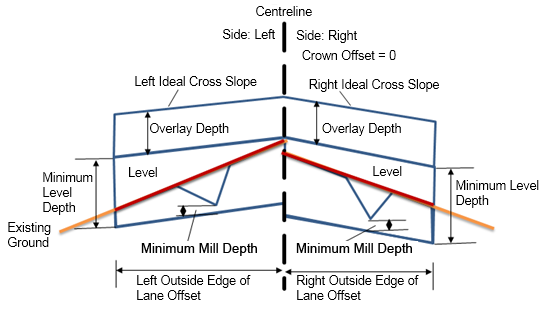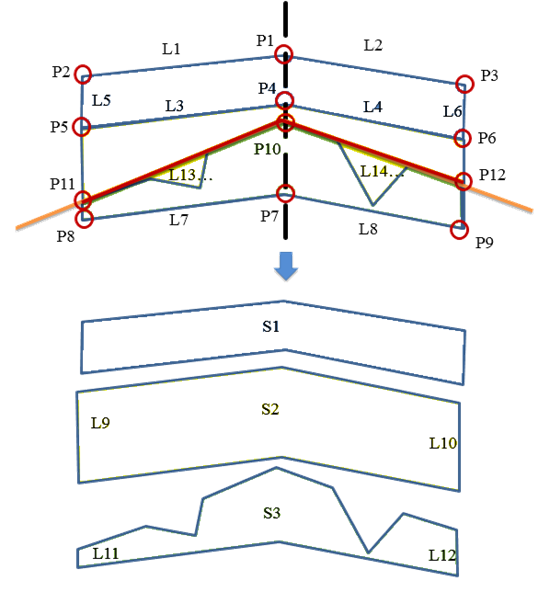This subassembly adds an overlay layer to an existing crowned carriageway, with either a levelling and milling layer added as required.

Attachment
The attachment point is the crown point of the overlay layer with finished ground crossfall.
Input Parameters
| Parameter | Description | Type | Default |
|---|---|---|---|
| Crown Offset | Positive or negative offset of the crown point | Numeric | 0.000m |
| Design Lane Width same as Existing Lane Width |
|
User defined | No |
| Inside Edge of Existing Left Lane | This is the start point for calculating existing ground slope for the left lane | Numeric | 0.000m |
| Inside Edge of Existing Right Lane | This is the start point for calculating existing ground slope for the right lane | Numeric | 0.000m |
| Outside Edge of Existing Left Lane | This is the end point for calculating existing ground slope for the left lane | Numeric | 12.000m |
| Outside Edge of Existing Right Lane | This is the end point for calculating existing ground slope for the right lane | Numeric | -12.000m |
| Use Profile Options | Select to tie the inside edge of an overlay to a profile, or adjust level to minimum level depth | User defined | Minimum Level Depth |
| Overlay Depth | Depth of the overlay layer | Numeric, positive | 0.300m |
| Right and Left Overlay Slope Options | Specifies right and left overlay slope options
Tip: Flapping is a term used to describe how the Corrected Crossfall for an overlay in a rehab subassembly is calculated. Flapping outcomes are different, relative to the Slope Tolerance and the Slope Difference between existing ground crossfall and ideal crossfall. If the Slope Difference is less than the Slope Tolerance for the subassembly, then the use case is considered 'within tolerance'. If the Slope Difference is greater than the Slope Tolerance for the subassembly, then the use case is considered 'without tolerance'.
Note: Slope Tolerance is an absolute value. Therefore, for either a Slope Difference of 0.4% or -0.4%, both have an absolute value of 0.4%. If the Slope Tolerance is 0.5%, the 0.4% absolute Slope Difference would be considered within tolerance.
|
User defined | User Defined Without Flapping |
| Left Ideal Crossfall | Specifies user defined left ideal crossfall | User defined, numeric | -2.00% |
| Left Minimum Level Depth | The minimum level depth between the existing surface and the bottom of the left overlay layer | Numeric, positive | 0.600m |
| Left Minimum Mill Depth | The minimum mill depth below the existing surface and the bottom of the left overlay layer | Numeric, positive | 0.300m |
| Left Slope Tolerance | Tolerance for varying the left overlay slope | Numeric, positive | 0.50% |
| Right Overlay Slope Options | Specifies right overlay slope options | User defined | User Defined Without Flapping |
| Right Ideal Crossfall | Specifies user defined right ideal crossfall | Numeric | -2.00% |
| Right Minimum Level Depth | The minimum level depth between the existing surface and the bottom of the right overlay layer | Numeric, positive. | 0.600m |
| Right Minimum Mill Depth | The minimum mill depth below the existing surface and the bottom of the right overlay layer | Numeric, positive | 0.300m |
| Right Slope Tolerance | Tolerance for varying the right overlay slope | Numeric, positive | 0.50% |
| Left Lane Width | The left lane width, determined by the offset of the outside edge of the left lane from the inside edge of left lane | Numeric, negative. | -12.000m |
| Right Lane Width | The right lane width, determined by the offset of the outside edge of the right lane from the inside edge of right lane | Numeric, positive. | 12,000m |
Output Parameters
| Parameter | Description | Type | Default |
|---|---|---|---|
| Left Corrected Crossfall | This is the adjusted crossfall for the left side of the road, which has been optimised to match, as closely as possible, the rehab subassembly parameters you specified. | Numeric, negative | -2.00% |
| Right Corrected Crossfall | This is the adjusted crossfall for the right side of the road, which has been optimised to match, as closely as possible, the rehab subassembly parameters you specified. | Numeric, negative | -2.00% |
| Left Existing Ground Slope | The crossfall (%) of the existing ground profile for the left lane, calculated from the inside edge of the left lane to the outside edge of the left lane. | Numeric, negative | n/a |
| Right Existing Ground Slope | The crossfall (%) of the existing ground profile for the right side of the road, calculated from the inside edge of the right lane to the outside edge of the right lane. | Numeric, negative | n/a |
Target Parameters
| Parameter | Description | Required? |
|---|---|---|
| Target Surface | Name of the surface defining the existing carriageway | Yes |
| Crown Offset Target | Name of the object defining the offset of the crown point. The following object types can be used as targets for specifying this offset: alignments, polylines, feature lines or survey figures. | No |
| Left Lane Width Target | Name of the object defining the offset of the outside edge of left lane . The following object types can be used as targets for specifying this offset: alignments, polylines, feature lines or survey figures. | No |
| Right Lane Width Target | Name of the object defining the offset of the outside edge of right lane . The following object types can be used as targets for specifying this offset: alignments, polylines, feature lines or survey figures. | No |
| Left Inside Edge of Existing Lane Offset Target | Name of the object defining the left inside sample point offset will be used to calculate the existing surface slope. The following object types can be used as targets for specifying this offset: alignments, polylines, feature lines or survey figures. | No |
| Left Outside Edge of Existing Lane Offset Target | Name of the object defining the left outside sample point offset will be used to calculate the existing surface slope. The following object types can be used as targets for specifying this offset: alignments, polylines, feature lines or survey figures. | No |
| Right Inside Edge of Existing Lane Offset Target | Name of the object defining the right inside sample point offset will be used to calculate the existing surface slope. The following object types can be used as targets for specifying this offset: alignments, polylines, feature lines or survey figures. | No |
| Right Outside Edge of Existing Lane Offset Target | Name of the object defining the right outside sample point offset will be used to calculate the existing surface slope. The following object types can be used as targets for specifying this offset: alignments, polylines, feature lines or survey figures. | No |
Behaviour
This overlay layer assumes that flapping is applied within slope tolerance. Level at the crown will meet both sides of the carriageway.
Point, Link and Shape Codes
| Point, Link or Shape | Code | Description |
|---|---|---|
| P1, | Crown | Crown point for top of overlay |
| P2, P3 | EOV | Edges of overlay for finished gradient |
| P4 | Crown_Overlay | Crown point for bottom of overlay |
| P5, P6 | EOV_Overlay | Edges of bottom of overlay for left and right side of the road |
| P7 | Crown_Milling | Crown point for top of mill |
| P8, P9 | EOV_Milling | Edges of mill for right and left side of road |
| L1, L2 | Top, Pave | Top of overlay for left and right side of the road |
| L3, L4, L5, L6 | Overlay | Overlay links for the left and right side of the road |
| L7, L8 | Level, Mill, Datum | Links for the milling layer |
| L9, L10 | Level | Level links for the left and right side of the road |
| L11, L12 | Mill | Mill links for the left and right side of the road |
| S1 | Overlay | Area between the top and bottom of the overlay |
| S2 | Level | Area between the top and bottom of the elevation |
| S3 | Mill | Area between the top and bottom of the mill |
Coding Diagram
